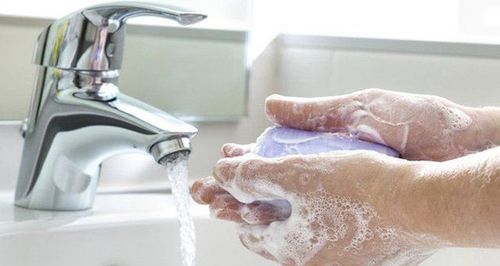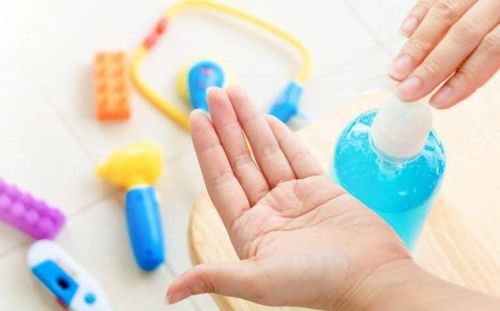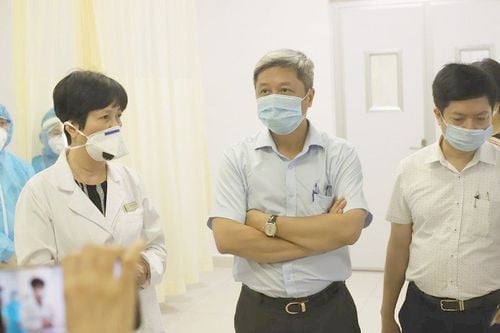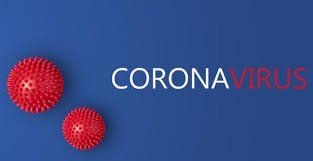This is an automatically translated article.
In the face of the complicated development of the coronavirus epidemic, the prevention of the spread is being focused. Besides wearing a mask, the best way to prevent COVID-19 is to regularly wash your hands with soap and water for at least 30 seconds.1. Routine hand washing technique
Routine hand washing is indicated for the purpose of removing dirt and microorganisms present on the hands. Recommended hand sanitizer time is usually 30 seconds to 1 minute with soap (water or cake) and clean water. The specific steps are as follows:
Step 1: Remove jewelry, watches, ... that are on your hand and put them in your personal pocket. Wet hands with clean water. Take about 3 - 5 ml of hand soap solution into the palm of your hand, or rub the bar of soap that covers the palm and back of the hand. Step 2: Rub your hands vigorously for about 1 minute (rub your palms together, then rub one palm on the back of the other and vice versa). Step 3: Continue squeezing your right fingers between your left fingers, then switch sides. Make a fist to rub the backs of these fingers against the palm of the other, and vice versa. Step 4: Rub the left thumb into the right palm (so that the palm hugs the thumb), and vice versa. Continue rubbing these fingertips into the other palm and switch sides. Step 5: Wash your hands under running water, let your hands lie lower than your elbows for all microorganisms to wash down into the tub. Step 6: Dry your hands with a clean towel. Note, steps 2 - 4 need to be done at least 5 times, but the time to perform each step should not exceed 15 seconds. In addition, it is necessary to adjust the water faucet to a moderate speed, and do not let the clothes touch the sink during hand washing.
If there is also visible dirt in the nail, use the nail to push it out. Take advantage of the towel you just used to dry your hands to close the faucet, do not use washed hands to directly close the faucet.
2. Wash your hands dry with alcohol-based solution
Dry hand washing using water with an alcohol-based solution should only be applied when it is not possible to wash hands with water and soap, moreover, the hands are not visibly dirty. If organic contamination is present, it is necessary to find a place where routine hand washing can be found as described in section 1.
The technique of washing hands without water with an alcohol-based solution follows the same steps as traditional hand washing, namely:
Step 1: Put 3-5 ml of alcohol-based hand sanitizer in the palm of your hand. Step 2: Rub your hands vigorously for 1 minute, rub your palms together, then rub one palm over the back of the other and switch sides. Step 3: Gently rub these fingers between the other fingers. Rub the back of one hand to cup the palm of the other hand and vice versa. Step 4: With this palm, hold the other thumb and rub it vigorously, then switch sides. Finally rub the fingertips of the left hand into the palm of the right hand and vice versa. Note: When you have completed step 4 above and your hands are still not dry, repeat steps 2 - 4 until your hands are completely dry. Influenza viruses will generally be inactivated after about 3-4 minutes using an alcohol-based hand sanitizer of 60 degrees or more. Therefore, it should be noted that if after washing hands quickly, the virus has not been destroyed, there is still a risk of spreading to others.
If you make your own hand sanitizer at home according to the guidelines of the World Health Organization (WHO), it must be left after 72 hours to use. This time is enough to ensure that the bacteria germs (if any) in the solution are destroyed.
3. Means required when washing hands
Clean tap water, soap, and hand towels should be readily available and in appropriate locations.3.1. Soap and hand sanitizer On the current market, hand soap is quite diverse, from water solution to traditional cake. The following types can be distinguished:
Regular soap (neutral, bar or liquid)

Xà phòng rửa tay thông thường dạng soap
Soap contains esterified fatty acids and sodium / potassium hydroxide. This type will take away the bacteria that are present, loose on the skin and can be used in routine hand washing. The most commonly used hand sanitizer in hospitals is Pose liquid soap.
Disinfectant soap (in the form of bars or solutions) Contains an antiseptic with the main active ingredient usually Para-chloro-meta xytenol. Antiseptic hand soap can be used in routine hand washing.
Antiseptic hand sanitizer Ingredients include 2 - 4% chlorhexidine; or 5 - 7% providone iodine; or 1% triclosan. Used in surgical hand washing before wearing gloves and conducting penetration, contact with mucous membranes, or subcutaneous tissues. The types of hand sanitizers used in hospitals are Microshield 2% and 4% (in the operating room).
Non-Aqueous Disinfectant Solution May contain one of the following chemicals: Alcohol, Chlorhexidine, Chlorine, Hexachlorophene, Iodine, Para chloro meta xylenol, quaternary ammonium compounds and Triclosan and may also contain a skin conditioner or fragrance. scent.
Experts say it's best to use a bottle of hand sanitizer with a hose. The solution container needs to:
Have a label clearly stating the type of hand sanitizer it contains; Can be mounted on the wall or injection vehicle, or placed in convenient locations for users; The container must be cleaned before adding fresh solution if reused. Note, do not put the new solution into a partially used bottle because it will cause the soap to become contaminated. If hand sanitizer is not available, the bar of soap must be placed in a soap dispenser with a hole to allow residual water to flow down after use. It is advisable to cut bar soap into small pieces to renew it more often, thereby preventing the growth of microorganisms.
3.2. Hand sanitizer Hand sanitizer should be running water, tap water or clean water stored in a container with a tight-fitting lid and shut off faucet/valve. In addition, the faucet needs to have a lever, the hand basin must always be kept clean, and placed in a convenient location. Stagnant water contained in the pond/lubricant can be a breeding ground for disease-causing bacteria, so it should not be used.
3.3. Dry hands Do not use reusable towels. If cotton towels are used, wash them daily, or store tissues in a clean container.

Làm khô tay bằng khăn và giặt sạch hàng ngày
Hospitals should place towels in any location where there is contact with patients, such as changing rooms, clinics, laboratories and patient care rooms.
If you don't have a towel, you can let your hands dry naturally, do not wipe on clothes or uniforms. Note: Air blowers should not be used to clean hands because microorganisms will also easily be blown onto other surfaces, as well as back into hands, body and the air.
For respiratory infections, including coronavirus pneumonia, WHO recommends masks and emphasizes proper hand washing. Hands are often in direct contact with body secretions and contaminated surfaces. So wash your hands before eating, especially when coughing, sneezing, before removing/refitting contact lenses, caring for a wound or patient, cooking food, after using the toilet or changing diapers, playing and Feed the animals, or clean up the trash...
Please dial HOTLINE for more information or register for an appointment HERE. Download MyVinmec app to make appointments faster and to manage your bookings easily.













